
INSIDE THIS EDITION:
- MAKING HISTORY COME ALIVE by Lee Ashcraft
- KENT STATE AND ME by Ruth Mills
- ABOUT ASIAN/PACIFIC AMERICAN HERITAGE MONTH
- GET THE MESSAGE OUT ABOUT LLC: How you can help the Marketing Committee spread the word!
- May is also MENTAL HEALTH AWARENESS MONTH
- HOME by Carl Sandburg
- FROM STAGES OF FREEDOM: Who has a seat at the table? An exhibition guest curated by Aaron Castillo on view May 1-31
Making History Come Alive
by Lee Ashcraft
Class members from “Rhode Island in Revolutionary Era: 1763-1790” recently visited the Armory of the Pawtuxet Rangers Militia Company in Warwick. Colonel Ron Barnes, Commanding Officer of the Company hosted the class and provided a history of the Rangers and the role of militia units in the Revolutionary Era, and he then led a tour of exhibits including uniforms, medical equipment and armaments. Members were particularly interested in artifacts from the Gaspee Affair as they had recently studied that event.
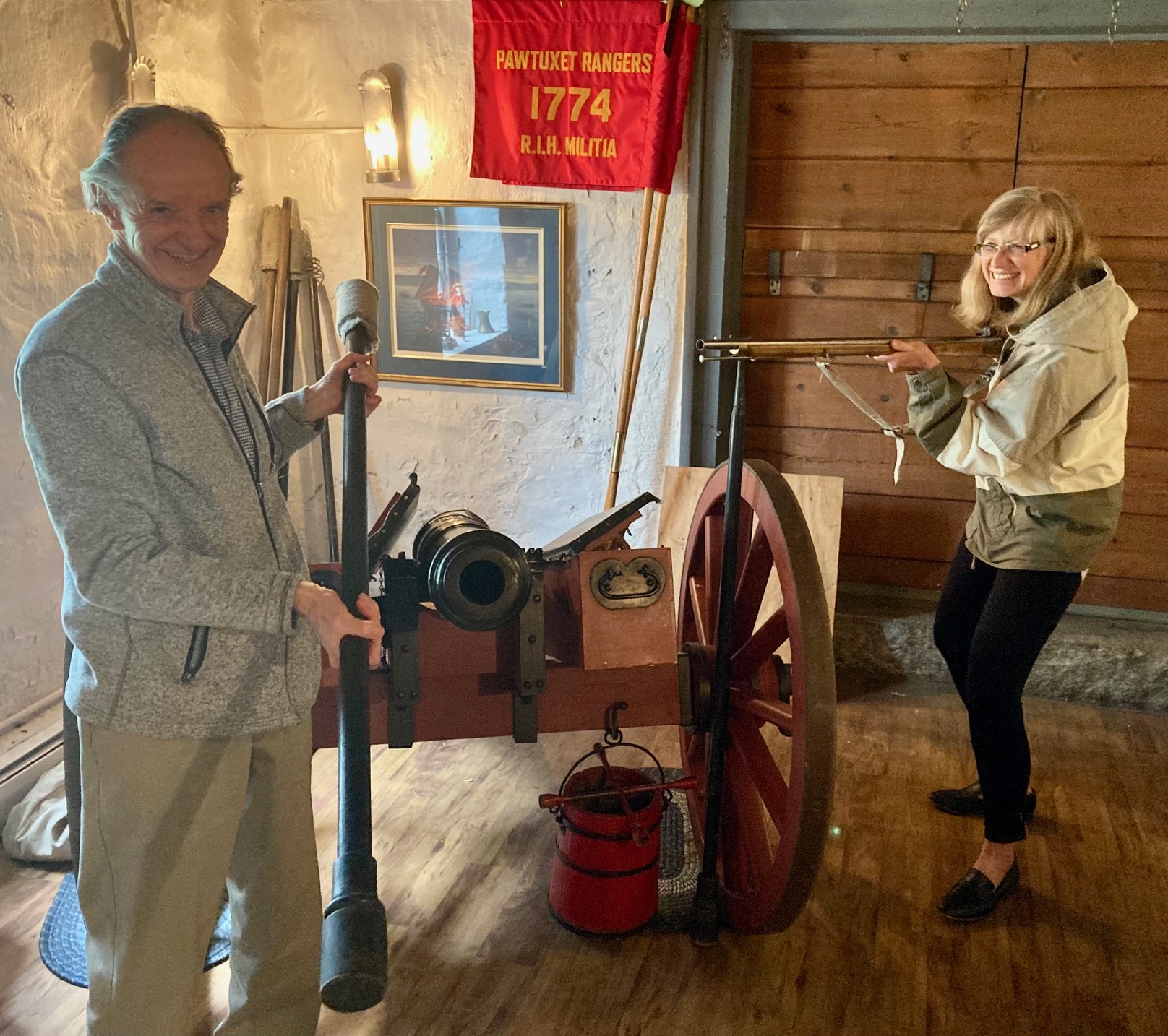
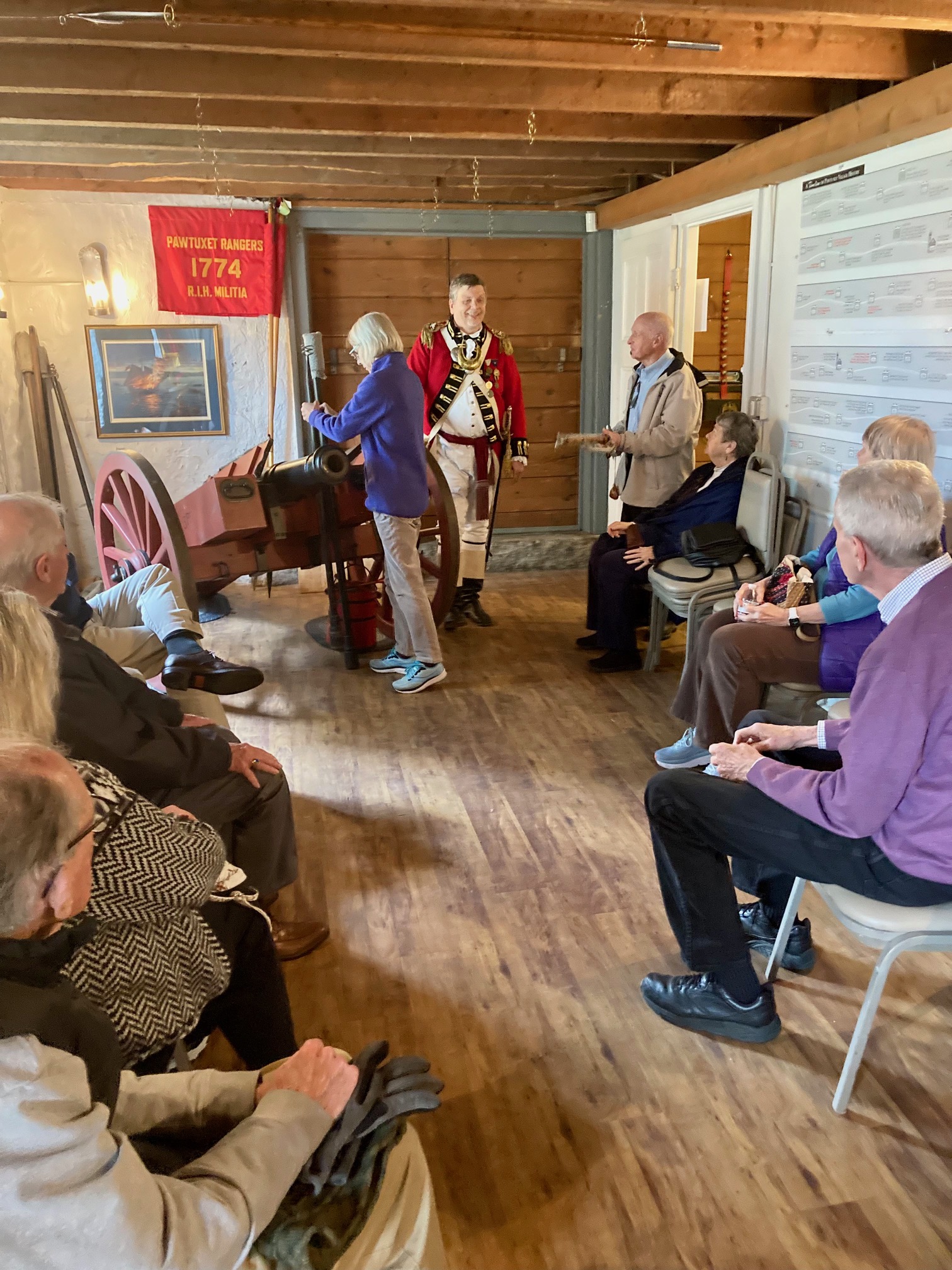
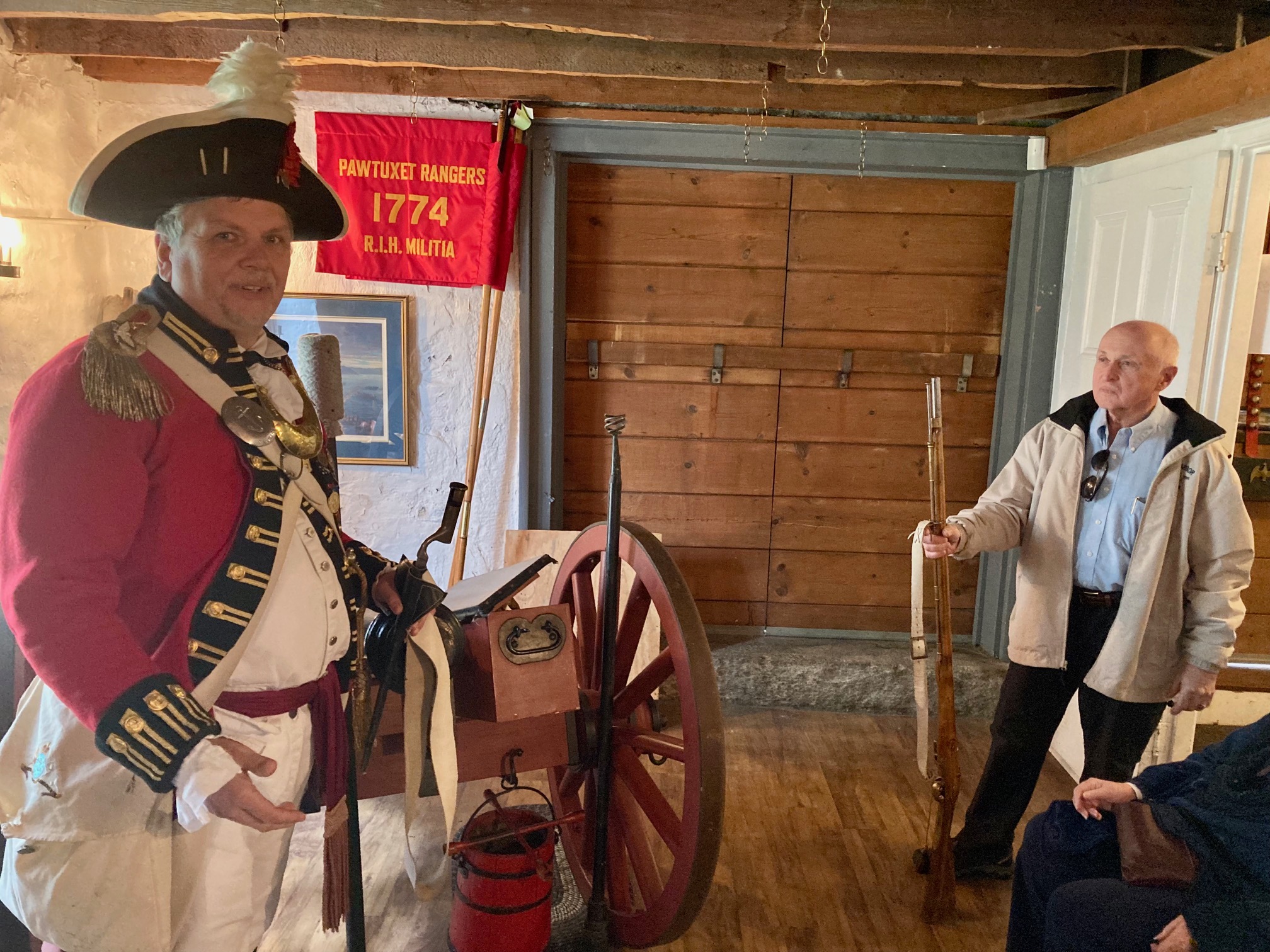
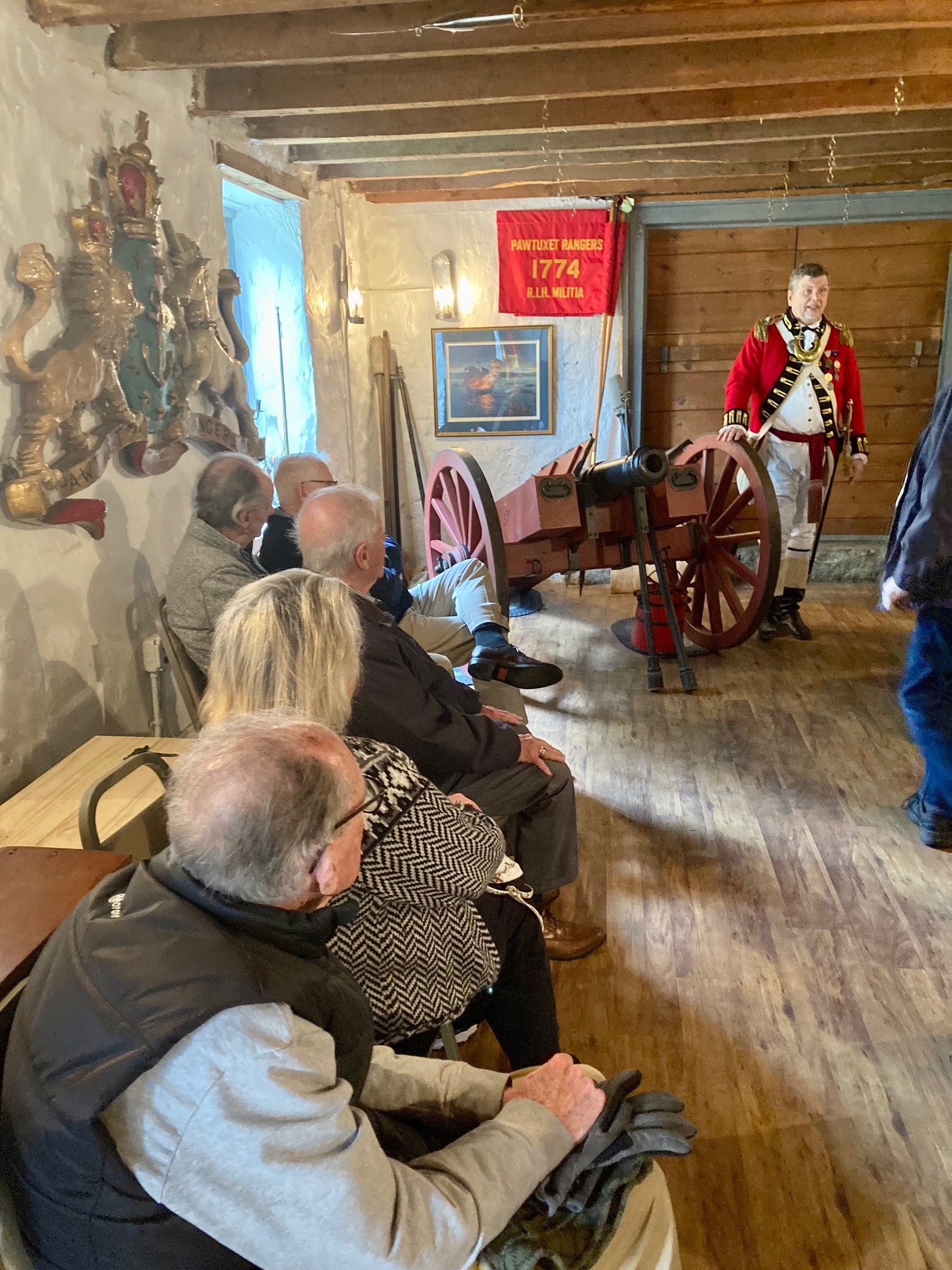
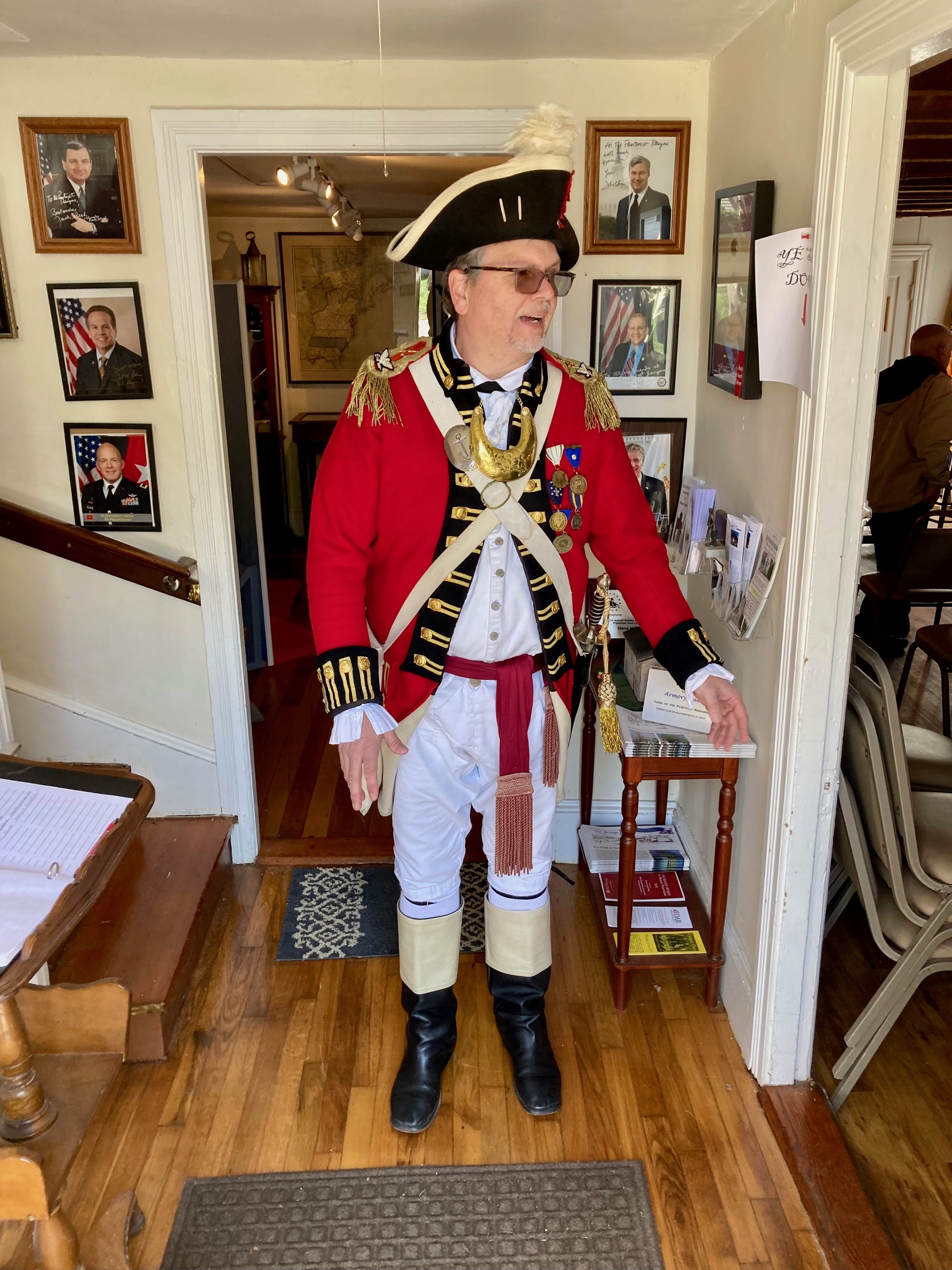
Kent State and Me
by Ruth Mills
The Kent State shootings (also known as the May 4 massacre and the Kent State massacre[) resulted in the killing of four and wounding of nine unarmed college students by the Ohio National Guard on the Kent State University campus. The shootings took place on May 4, 1970, during a peace rally opposing the expanding involvement of the Vietnam War into Cambodia by United States military forces as well as protesting the National Guard presence on campus. This incident marked the first time a student was killed in an anti-war gathering in United States history. (Wikipedia)
A huge poster of President Nixon was burning just a few hundred feet from my bedroom window. Thousands of agitated students from our two local colleges had gathered in the village park across the street. The park was not big enough to contain them all. Quite a few were standing on our lawn and about a dozen stood on our porch. My parents locked the front door, something that we had never done. I wanted to go out, just to observe, but my parents were adamant. I was not to go out.
Earlier that day my mother had watched in horror as a mock funeral procession with four caskets and hundreds of students made their way up Main Street. She held her breath as a convoy of National Guardsmen from nearby Camp Drum made their way up the street at the same time. Both sides stared straight ahead, never looking at each other.
Our tiny town of 6000 residents plus 4000 students was suddenly filled with tension as we learned that four unarmed students were killed in Ohio by our National Guard. I was finishing the end of my junior year in high school. For the past several years, it had seemed as if the world was coming apart—the Watts Riots in 1965, the Detroit and Newark riots in 1967, and the riots at the 1968 Democratic Convention in Chicago, to name just a few. I remember my father commenting on a newscast of the Detroit riots, saying it sounded like a war zone. It felt threatening and unnerving to my adolescent self.
My parents were law and order Republicans. My father was also a fundamentalist Baptist minister. No question where they stood. Instead of protesting, people with grievances should pray and trust the Lord. I did not consciously question their beliefs. In fact, in my sophomore year I had to write a term paper about a social issue. I chose to write about protests. My conclusion was simplistic and parent-approved. Jesus was the answer to all earthly problems.
My initial reaction to the Kent State Massacre was similar. If those students had focused on their studies and doing what they were supposed to do, this would not have happened. I dismissed the fact that they were upset about the expansion of the war into Cambodia, where some of them might be sent to die.
Like me, many of my classmates believed that the students got what they deserved. Then Mr. Franklin, our eleventh grade Social Studies teacher, pointed out a fact that none of us had considered. We are a nation of laws. We have the right to protest our government. Everyone is entitled to a trial by jury. We are considered innocent until proven guilty. And the punishment should be appropriate for the crime. Did these students get a trial? Were they proven guilty? Did the act of protesting deserve the death penalty?
I began to look more closely at the facts. Jeff Miller appeared to be the most “guilty.” He had thrown a tear gas canister back at the Guardsmen, waved his middle finger, and called them pigs. He felt strongly about making his voice heard. He got the death penalty, without the benefit of a trial.
Allison Krause also participated in the protests. She was photographed placing a flower in the barrel of one of the guns held by a National Guardsman. She told him “flowers are better than bullets.” She actually agreed with the Guard presence after the ROTC building was burned. She got the death penalty, without the benefit of a trial.
Sandy Scheuer was changing classes. She had not participated in any protests. She was simply in the wrong place at the wrong time. She got the death penalty, without the benefit of a trial.
Bill Schroeder had not participated in any protests and was a member of the ROTC. He was changing classes when he heard shots being fired. As he tried to run away, he was shot in the back. He got the death penalty, without the benefit of a trial.
Nine other students were injured, including one who was permanently paralyzed. None of them had the benefit of a trial.
The protests in my town ended quietly. My spiritual and political journey, however, was just beginning.
And so I have come to doubt
All that I once held as true.
“Kathy’s Song”
Simon and Garfunkel
About Asian/Pacific Heritage Month
May is Asian/Pacific American Heritage Month – a celebration of Asians and Pacific Islanders in the United States. A rather broad term, Asian/Pacific encompasses all of the Asian continent and the Pacific islands of Melanesia (New Guinea, New Caledonia, Vanuatu, Fiji and the Solomon Islands), Micronesia (Marianas, Guam, Wake Island, Palau, Marshall Islands, Kiribati, Nauru and the Federated States of Micronesia) and Polynesia (New Zealand, Hawaiian Islands, Rotuma, Midway Islands, Samoa, American Samoa, Tonga, Tuvalu, Cook Islands, French Polynesia and Easter Island).
Like most commemorative months, Asian/Pacific American Heritage Month originated with Congress. In 1977 Reps. Frank Horton of New York introduced House Joint Resolution 540 to proclaim the first ten days in May as Pacific/Asian American Heritage Week. In the same year, Senator Daniel Inouye introduced a similar resolution, Senate Joint Resolution 72. Neither of these resolutions passed, so in June 1978, Rep. Horton introduced House Joint Resolution 1007. This resolution proposed that the President should “proclaim a week, which is to include the seventh and tenth of the month, during the first ten days in May of 1979 as ‘Asian/Pacific American Heritage Week.’” This joint resolution was passed by the House and then the Senate and was signed by President Jimmy Carter on October 5, 1978 to become Public Law 95-419 (PDF, 158kb). This law amended the original language of the bill and directed the President to issue a proclamation for the “7 day period beginning on May 4, 1979 as ‘Asian/Pacific American Heritage Week.’” During the next decade, presidents passed annual proclamations for Asian/Pacific American Heritage Week until 1990 when Congress passed Public Law 101-283 (PDF, 166kb) which expanded the observance to a month for 1990. Then in 1992, Congress passed Public Law 102-450 (PDF, 285kb) which annually designated May as Asian/Pacific American Heritage Month.
The month of May was chosen to commemorate the immigration of the first Japanese to the United States on May 7, 1843, and to mark the anniversary of the completion of the transcontinental railroad on May 10, 1869. The majority of the workers who laid the tracks were Chinese immigrants.
How you can help bring new members into LLC?
by Art Norwalk
Chair, Marketing Committee
The Marketing Committee is planning several new initiatives to inform non-members about the value and enjoyment that come with membership in LLC – and you can help get the message out.
One thing we’re going to try this summer is to create posters giving an idea of the opportunities available in the Fall session and inviting non-members to request their own catalogs. There are two things you can do to help the posters do their job:
- Send us the names and addresses of places in your community where posters are displayed. Possibilities include supermarkets, coffee houses, senior centers, etc. Email your ideas to Diana Grady at [email protected]
- Volunteer to put the posters up in your community. Tell Diana ([email protected]) how many places you’d like to visit and we’ll get the posters to you.
Looking a bit farther out, the committee will be creating presentation materials and handouts for LLC representatives to use at public speaking engagements around Rhode Island and nearby Massachusetts. You can give us some crucial help by identifying organizations in your community that welcome guest speakers, along with the name and contact information for the person who books the speakers. Send the information to [email protected].
Adding new members will help LLC fulfill its mission of offering quality educational opportunities and create new opportunities for all of us to make new friends.
The Marketing Committee appreciates your help.
May is Mental Health Awareness Month
Mental Health Awareness Month was established in 1949 to increase awareness of the importance of mental health and wellness in Americans’ lives and to celebrate recovery from mental illness. It was founded by the Mental Health America organization (then known as the National Association for Mental Health) in order to raise awareness and educate the public about mental illness, including conditions like depression, schizophrenia, and bipolar disorder, and reduce the stigma surrounding mental illness.
Mental Health Month aims to raise awareness regarding the trauma and societal impact that mental illness can have on the physical, emotional, and mental well-being of children, families, and communities as a whole.
The Inspiring History of Mental Health Awareness Month – Lehigh Center
May is Mental Health Awareness Month | AHA
Successful Mental Health Awareness Efforts
Over the past 20 years, the Substance Abuse and Mental Health Services Administration and other organizations within the U.S. The Department of Health and Human Services have been making great strides in their efforts to increase the importance of understanding, openness, treatment, and prevention of mental health issues.
Some of the most successful efforts that have promoted acceptance, support, prevention, and recover from mental health conditions include but are not limited to:
- The Affordable Care Act – This act expanded health insurance coverage to approximately 30 million Americans. An estimated 11 million of these individuals will now have access to substance abuse and/or mental health service needs.
- The Community Mental Health Services Block Grant – This grant provides financial assistance to states and territories to carry out state plans to offer comprehensive community-based mental health services and evidence-based practices to adults with serious mental illnesses and children with serious emotional disturbances.
- Mental Health Parity and Addiction Equity Act of 2008 – This act eliminated the practice of unequal health treatment and improved access to much needed mental health and substance use disorder treatment services through more equitable insurance coverage.
- The Garrett Lee Smith State/Tribal Suicide Prevention Program – This program facilitates coordination across government agencies and the private sector in the development, implementation, and evaluation of youth suicide prevention and early intervention plans among youth-serving institutions, such as schools, educational institutions, juvenile justice systems, substance abuse programs, primary care, mental health programs, foster care systems, and other organizations.
HOME
by Carl Sandburg
Here is a thing my heart wishes the world had more of:
I heard it in the air of one night when I listened
To a mother singing softly to a child restless and angry in the darkness.
Who Has a Seat at the Table?
An exhibition guest curated by Aaron Castillo
May 1 - 31, 2023
On view in the Rhode Island Room during regular library hours
Rhode Island Reading Room
Providence Public Library
150 Empire Street, Providence
Free & Open to the Public
The exhibit explores the histories of five displaced communities in Providence, Rhode Island: The Narragansett Tribe, Colonial African Americans, the Chinese of Chinatown, the Black residents of Lippitt Hill, and Cape Verdeans from Fox Point, and provides context by detailing what happened to these communities and examining how food and foodways can serve as a means of remembrance. Along with each history is an accompanying piece by artists Dana Heng and Nafis M. White that explores food and memory within the respective communities, revealing how we can preserve and remember these communities' legacy through food.
Guest Curator Aaron Castillo, Brown '23, did extensive research in PPL's Special Collections and curated this exhibit to create space and learn with other members of the community.
More Info/Register
Stages of Freedom [email protected]
Stages of Freedom · 10 Westminster Street · Providence · Rhode Island · 02903
